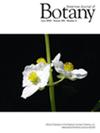Linkages among stem xylem transport, biomechanics, and storage in lianas and trees across three contrasting environments
Abstract
Premise
Stem xylem transports water and nutrients, mechanically supports aboveground tissues, and stores water and nonstructural carbohydrates. These three functions are associated with three types of cells—vessel, fiber, and parenchyma, respectively.
Methods
We measured stem theoretical hydraulic conductivity (Kt), modulus of elasticity (MOE), tissue water content, starch, soluble sugars, cellulose, and xylem anatomical traits in 15 liana and 16 tree species across three contrasting sites in Southwest China.
Results
Lianas had higher hydraulic efficiency and tissue water content, but lower MOE and cellulose than trees. Storage traits (starch and soluble sugars) did not significantly differ between lianas and trees, and trait variation was explained mainly by site, highlighting how environment shapes plant storage strategies. Kt was significantly positively correlated with vessel diameter and vessel area fraction in lianas and all species combined. The MOE was significantly positively correlated with fiber area fraction, wood density, and cellulose in lianas and across all species. The tissue water content was significantly associated with parenchyma area fraction in lianas. Support function was strongly linked with transport and storage functions in lianas. In trees, transport and support functions were not correlated, while storage function was tightly linked with transport and support functions.
Conclusions
These findings enhance our understanding of the relationship between stem xylem structure and function in lianas and trees, providing valuable insights into how plants adapt to environmental changes and the distinct ecological strategies employed by lianas and by trees to balance the demands of hydraulic transport, mechanical support, and storage.


 求助内容:
求助内容: 应助结果提醒方式:
应助结果提醒方式:


